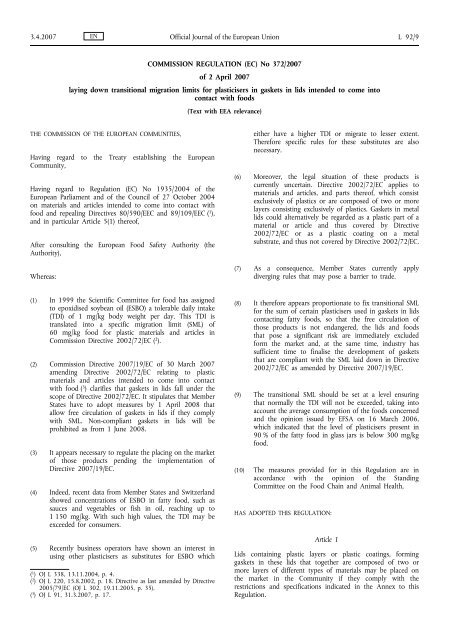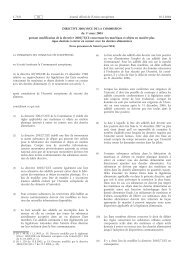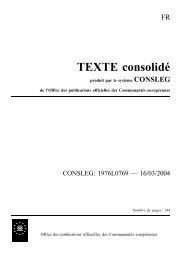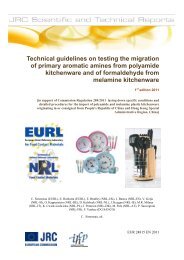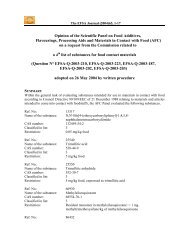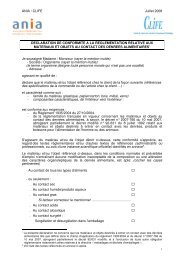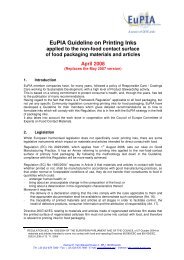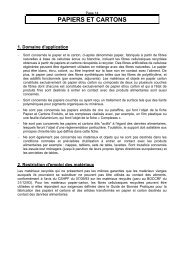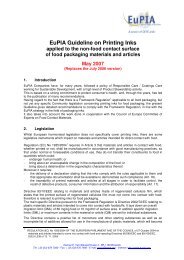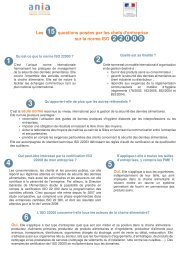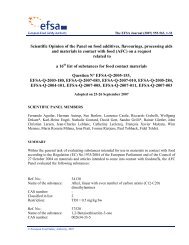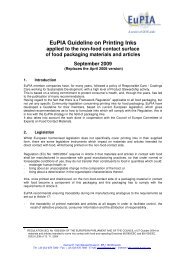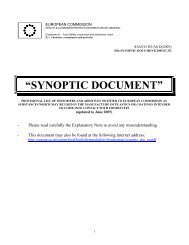COMMISSION REGULATION (EC) No 372/2007 of 2 ... - EUR-Lex
COMMISSION REGULATION (EC) No 372/2007 of 2 ... - EUR-Lex
COMMISSION REGULATION (EC) No 372/2007 of 2 ... - EUR-Lex
Create successful ePaper yourself
Turn your PDF publications into a flip-book with our unique Google optimized e-Paper software.
EN3.4.<strong>2007</strong> Official Journal <strong>of</strong> the European Union L 92/9<strong>COMMISSION</strong> <strong>REGULATION</strong> (<strong>EC</strong>) <strong>No</strong> <strong>372</strong>/<strong>2007</strong><strong>of</strong> 2 April <strong>2007</strong>laying down transitional migration limits for plasticisers in gaskets in lids intended to come intocontact with foods(Text with EEA relevance)THE <strong>COMMISSION</strong> OF THE <strong>EUR</strong>OPEAN COMMUNITIES,Having regard to the Treaty establishing the EuropeanCommunity,Having regard to Regulation (<strong>EC</strong>) <strong>No</strong> 1935/2004 <strong>of</strong> theEuropean Parliament and <strong>of</strong> the Council <strong>of</strong> 27 October 2004on materials and articles intended to come into contact withfood and repealing Directives 80/590/E<strong>EC</strong> and 89/109/E<strong>EC</strong> ( 1 ),and in particular Article 5(1) there<strong>of</strong>,After consulting the European Food Safety Authority (theAuthority),Whereas:either have a higher TDI or migrate to lesser extent.Therefore specific rules for these substitutes are alsonecessary.(6) Moreover, the legal situation <strong>of</strong> these products iscurrently uncertain. Directive 2002/72/<strong>EC</strong> applies tomaterials and articles, and parts there<strong>of</strong>, which consistexclusively <strong>of</strong> plastics or are composed <strong>of</strong> two or morelayers consisting exclusively <strong>of</strong> plastics. Gaskets in metallids could alternatively be regarded as a plastic part <strong>of</strong> amaterial or article and thus covered by Directive2002/72/<strong>EC</strong> or as a plastic coating on a metalsubstrate, and thus not covered by Directive 2002/72/<strong>EC</strong>.(7) As a consequence, Member States currently applydiverging rules that may pose a barrier to trade.(1) In 1999 the Scientific Committee for food has assignedto epoxidised soybean oil (ESBO) a tolerable daily intake(TDI) <strong>of</strong> 1 mg/kg body weight per day. This TDI istranslated into a specific migration limit (SML) <strong>of</strong>60 mg/kg food for plastic materials and articles inCommission Directive 2002/72/<strong>EC</strong> ( 2 ).(2) Commission Directive <strong>2007</strong>/19/<strong>EC</strong> <strong>of</strong> 30 March <strong>2007</strong>amending Directive 2002/72/<strong>EC</strong> relating to plasticmaterials and articles intended to come into contactwith food ( 3 ) clarifies that gaskets in lids fall under thescope <strong>of</strong> Directive 2002/72/<strong>EC</strong>. It stipulates that MemberStates have to adopt measures by 1 April 2008 thatallow free circulation <strong>of</strong> gaskets in lids if they complywith SML. <strong>No</strong>n-compliant gaskets in lids will beprohibited as from 1 June 2008.(3) It appears necessary to regulate the placing on the market<strong>of</strong> those products pending the implementation <strong>of</strong>Directive <strong>2007</strong>/19/<strong>EC</strong>.(4) Indeed, recent data from Member States and Switzerlandshowed concentrations <strong>of</strong> ESBO in fatty food, such assauces and vegetables or fish in oil, reaching up to1 150 mg/kg. With such high values, the TDI may beexceeded for consumers.(5) Recently business operators have shown an interest inusing other plasticisers as substitutes for ESBO which( 1 ) OJ L 338, 13.11.2004, p. 4.( 2 ) OJ L 220, 15.8.2002, p. 18. Directive as last amended by Directive2005/79/<strong>EC</strong> (OJ L 302, 19.11.2005, p. 35).( 3 ) OJ L 91, 31.3.<strong>2007</strong>, p. 17.(8) It therefore appears proportionate to fix transitional SMLfor the sum <strong>of</strong> certain plasticisers used in gaskets in lidscontacting fatty foods, so that the free circulation <strong>of</strong>those products is not endangered, the lids and foodsthat pose a significant risk are immediately excludedform the market and, at the same time, industry hassufficient time to finalise the development <strong>of</strong> gasketsthat are compliant with the SML laid down in Directive2002/72/<strong>EC</strong> as amended by Directive <strong>2007</strong>/19/<strong>EC</strong>.(9) The transitional SML should be set at a level ensuringthat normally the TDI will not be exceeded, taking intoaccount the average consumption <strong>of</strong> the foods concernedand the opinion issued by EFSA on 16 March 2006,which indicated that the level <strong>of</strong> plasticisers present in90 % <strong>of</strong> the fatty food in glass jars is below 300 mg/kgfood.(10) The measures provided for in this Regulation are inaccordance with the opinion <strong>of</strong> the StandingCommittee on the Food Chain and Animal Health,HAS ADOPTED THIS <strong>REGULATION</strong>:Article 1Lids containing plastic layers or plastic coatings, forminggaskets in these lids that together are composed <strong>of</strong> two ormore layers <strong>of</strong> different types <strong>of</strong> materials may be placed onthe market in the Community if they comply with therestrictions and specifications indicated in the Annex to thisRegulation.
ENL 92/10 Official Journal <strong>of</strong> the European Union 3.4.<strong>2007</strong>Article 2This Regulation shall enter into force on the 20th day following its publication in the Official Journal <strong>of</strong> theEuropean Union.This Regulation shall apply until 30 June 2008.This Regulation shall be binding in its entirety and directly applicable in all Member States.Done at Brussels, 2 April <strong>2007</strong>.For the CommissionMarkos KYPRIANOUMember <strong>of</strong> the Commission
EN3.4.<strong>2007</strong> Official Journal <strong>of</strong> the European Union L 92/11ANNEXRestrictions and specifications related to plasticisers used in gaskets in lidsRef. <strong>No</strong> CAS <strong>No</strong> Name Restrictions and/or specifications(1) (2) (3) (4)88640 008013-07-8 Soybean oil, epoxidised(ESBO)For materials and articles intended for or brought into contactwith foods for which simulant D testing is required byDirective 85/572/E<strong>EC</strong> SML(T) ( 1 )( 2 ) = 300 mg/kg <strong>of</strong> food orfood simulants or 50 mg/dm 2 <strong>of</strong> the total food contactsurface <strong>of</strong> lid and sealed container.For materials and articles intended for or brought into contactwith infant formulae and follow-on formulae as defined byCommission Directive 91/321/E<strong>EC</strong> on infant formulae andfollow-on formulae and products according to Directive96/5/<strong>EC</strong> on processed cereal-based foods and baby foodsfor infants and young children SML = 30 mg/kg <strong>of</strong> food orfood simulant.For materials and articles intended for or brought into contactwith all other types <strong>of</strong> foods SML(T) ( 2 ) = 60 mg/kg <strong>of</strong> foodor food simulants or 10 mg/dm 2 <strong>of</strong> the total food contactsurface <strong>of</strong> lid and sealed container.30401 — Acetylated mono- anddiglycerides <strong>of</strong> fattyacidsFor materials and articles intended for or brought into contactwith foods for which simulant D testing is required byDirective 85/572/E<strong>EC</strong> SML(T) ( 2 ) = 300 mg/kg <strong>of</strong> food orfood simulants or 50 mg/dm 2 <strong>of</strong> the total food contactsurface <strong>of</strong> lid and sealed container.For materials and articles intended for or brought into contactwith all other types <strong>of</strong> foods SML(T) ( 2 ) = 60 mg/kg <strong>of</strong> foodor food simulants or 10 mg/dm 2 <strong>of</strong> the total food contactsurface <strong>of</strong> lid and sealed container.76815 — Polyester <strong>of</strong> adipic acidwith glycerol orpentaerythritol, esterswith even numbered,unbranched C 12 -C 22fatty acidsFor materials and articles intended for or brought into contactwith foods for which simulant D testing is required byDirective 85/572/E<strong>EC</strong> SML(T) ( 2 ) = 300 mg/kg <strong>of</strong> food orfood simulants or 50 mg/dm 2 <strong>of</strong> the total food contactsurface <strong>of</strong> lid and sealed container.For materials and articles intended for or brought into contactwith all other types <strong>of</strong> foods SML(T) ( 2 ) = 60 mg/kg <strong>of</strong> foodor food simulants or 10 mg/dm 2 <strong>of</strong> the total food contactsurface <strong>of</strong> lid and sealed container.93760 000077-90-7 Tri-n-butyl acetyl citrate For materials and articles intended for or brought into contactwith foods for which simulant D testing is required byDirective 85/572/E<strong>EC</strong> SML(T) ( 2 ) = 300 mg/kg <strong>of</strong> food orfood simulants or 50 mg/dm 2 <strong>of</strong> the total food contactsurface <strong>of</strong> lid and sealed container.For materials and articles intended for or brought into contactwith all other types <strong>of</strong> foods SML(T) ( 2 ) = 60 mg/kg <strong>of</strong> foodor food simulants or 10 mg/dm 2 <strong>of</strong> the total food contactsurface <strong>of</strong> lid and sealed container.
ENL 92/12 Official Journal <strong>of</strong> the European Union 3.4.<strong>2007</strong>(1) (2) (3) (4)56800 030899-62-8 Glycerol monolauratediacetateFor materials and articles intended for or brought into contactwith foods for which simulant D testing is required byDirective 85/572/E<strong>EC</strong> SML(T) ( 2 ) = 300 mg/kg <strong>of</strong> food orfood simulants or 50 mg/dm 2 <strong>of</strong> the total food contactsurface <strong>of</strong> lid and sealed container.For materials and articles intended for or brought into contactwith all other types <strong>of</strong> foods SML(T) ( 2 ) = 60 mg/kg <strong>of</strong> foodor food simulants or 10 mg/dm 2 <strong>of</strong> the total food contactsurface <strong>of</strong> lid and sealed container.30340 330198-91-9 12-(Acetoxy)stearicacid, 2,3-bis(acetoxy)-propyl esterFor materials and articles intended for or brought into contactwith foods for which simulant D testing is required byDirective 85/572/E<strong>EC</strong> SML(T) ( 2 ) = 300 mg/kg <strong>of</strong> food orfood simulants or 50 mg/dm 2 <strong>of</strong> the total food contactsurface <strong>of</strong> lid and sealed container.For materials and articles intended for or brought into contactwith all other types <strong>of</strong> foods SML(T) ( 2 ) = 60 mg/kg <strong>of</strong> foodor food simulants or 10 mg/dm 2 <strong>of</strong> the total food contactsurface <strong>of</strong> lid and sealed container.76866 — Polyesters <strong>of</strong> 1,2-propanediol and/or 1,3-and/or 1,4-butanedioland/or polypropyleneglycolwith adipic acid,also end-capped withacetic acid or fatty acidsC 12 -C 18 or n-octanoland/or n-decanolSML = 30 mg/kg <strong>of</strong> food or food simulants or 5 mg/dm 2 <strong>of</strong>the total food contact surface <strong>of</strong> lid and sealed container.( 1 ) ‘SML’ means specific migration limit.( 2 ) SML(T) in this specific case means that the specific migration limit shall not be exceeded by the sum <strong>of</strong> the migration levels <strong>of</strong> thesubstances mentioned with reference numbers 88640, 30401, 76815, 93760, 56800 and 30340.


